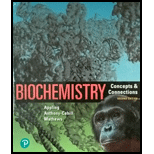
(a) Interpretation:
Acetylating agents such as acetic anhydride react preferentially with primary
Concept Introduction:
Amino acid has one central carbon atom which is capable of having four covalent bonds. The other four parts of amino acids are bound to each central carbon atom. A unique chemical group is bonded to each amino acid which is known as its side chain.
Proteins are large biological molecules made up of long chains of amino acid residues. Single polypeptide chain or two or more numbers of polypeptide chains are responsible for developing proteins. Proteins are the building block of the body. They have diverse functions like catalyzing
(b) Interpretation:
Acetylating agents such as acetic anhydride react preferentially with primary amines, iodoacetate reacts preferentially with sulfhydryl group, and ATP- dependent kinases preferentially add a phosphoryl group to side-chain hydroxyl or phenolic- OH groups. From this it should be identified which amino acid side chains or main-chain groups, in a polypeptide are most likely to be modified by treated with iodoacetate.
Concept Introduction:
Amino acid has one central carbon atom which is capable of having four covalent bonds. The other four parts of amino acids are bound to each central carbon atom. A unique chemical group is bonded to each amino acid which is known as its side chain.
Proteins are large biological molecules made up of long chains of amino acid residues. Single polypeptide chain or two or more numbers of polypeptide chains are responsible for developing proteins. Proteins are the building block of the body. They have diverse functions like catalyzing metabolic reaction, DNA (deoxyribonucleic acid) replication, transporting hormones and other molecules throughout the body, and responding to different stimuli. Post-translational modification (PTM) is a biological process post protein translation in which enzymatic modification of protein takes place either during the process of translation or post protein biosynthesis.
(c) Interpretation:
Acetylating agents such as acetic anhydride react preferentially with primary amines, iodoacetate reacts preferentially with sulfhydryl group, and ATP- dependent kinases preferentially add a phosphoryl group to side-chain hydroxyl or phenolic- OH groups. From this it should be identified which amino acid side chains or main-chain groups, in a polypeptide are most likely to be modified by treated with kinase + ATP.
Concept Introduction:
Amino acid has one central carbon atom which is capable of having four covalent bonds. The other four parts of amino acids are bound to each central carbon atom. A unique chemical group is bonded to each amino acid which is known as its side chain.
Proteins are large biological molecules made up of long chains of amino acid residues. Single polypeptide chain or two or more numbers of polypeptide chains are responsible for developing proteins. Proteins are the building block of the body. They have diverse functions like catalyzing metabolic reaction, DNA (deoxyribonucleic acid) replication, transporting hormones and other molecules throughout the body, and responding to different stimuli. Post-translational modification (PTM) is a biological process post protein translation in which enzymatic modification of protein takes place either during the process of translation or post protein biosynthesis.
Want to see the full answer?
Check out a sample textbook solution
Chapter 5 Solutions
Biochemistry: Concepts and Connections (2nd Edition)
 BiochemistryBiochemistryISBN:9781319114671Author:Lubert Stryer, Jeremy M. Berg, John L. Tymoczko, Gregory J. Gatto Jr.Publisher:W. H. Freeman
BiochemistryBiochemistryISBN:9781319114671Author:Lubert Stryer, Jeremy M. Berg, John L. Tymoczko, Gregory J. Gatto Jr.Publisher:W. H. Freeman Lehninger Principles of BiochemistryBiochemistryISBN:9781464126116Author:David L. Nelson, Michael M. CoxPublisher:W. H. Freeman
Lehninger Principles of BiochemistryBiochemistryISBN:9781464126116Author:David L. Nelson, Michael M. CoxPublisher:W. H. Freeman Fundamentals of Biochemistry: Life at the Molecul...BiochemistryISBN:9781118918401Author:Donald Voet, Judith G. Voet, Charlotte W. PrattPublisher:WILEY
Fundamentals of Biochemistry: Life at the Molecul...BiochemistryISBN:9781118918401Author:Donald Voet, Judith G. Voet, Charlotte W. PrattPublisher:WILEY BiochemistryBiochemistryISBN:9781305961135Author:Mary K. Campbell, Shawn O. Farrell, Owen M. McDougalPublisher:Cengage Learning
BiochemistryBiochemistryISBN:9781305961135Author:Mary K. Campbell, Shawn O. Farrell, Owen M. McDougalPublisher:Cengage Learning BiochemistryBiochemistryISBN:9781305577206Author:Reginald H. Garrett, Charles M. GrishamPublisher:Cengage Learning
BiochemistryBiochemistryISBN:9781305577206Author:Reginald H. Garrett, Charles M. GrishamPublisher:Cengage Learning Fundamentals of General, Organic, and Biological ...BiochemistryISBN:9780134015187Author:John E. McMurry, David S. Ballantine, Carl A. Hoeger, Virginia E. PetersonPublisher:PEARSON
Fundamentals of General, Organic, and Biological ...BiochemistryISBN:9780134015187Author:John E. McMurry, David S. Ballantine, Carl A. Hoeger, Virginia E. PetersonPublisher:PEARSON





